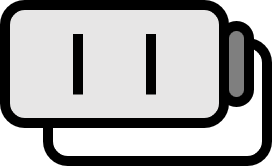Qubits: The Basic Unit of Information in Quantum Computers
| 양자정보이론 | ||||||||||||||||
[ 펼치기 · 접기 ]
| ||||||||||||||||
Definition1
$\mathbb{C}$ Let’s denote the two unit vectors in the vector space $\mathbb{C}^{2}$, $\begin{bmatrix} 1 \\ 0 \end{bmatrix}$, and $\begin{bmatrix} 0 \\ 1 \end{bmatrix}$ using Dirac notation as follows.
$$ \ket{0} = \begin{bmatrix} 1 \\ 0 \end{bmatrix}\qquad \ket{1} = \begin{bmatrix} 0 \\ 1 \end{bmatrix} $$
The element of the set $\left\{ \ket{0}, \ket{1} \right\}$ is called qubit.
$\mathbb{C}^{2}$’s $n$tensor product $\left( \mathbb{C}^{2} \right)^{\otimes n} = \overbrace{\mathbb{C}^{2} \otimes \cdots \otimes \mathbb{C}^{2}}^{n}$ standard basis
$$ \left\{ \ket{0} \otimes \cdots \otimes \ket{0}, \dots, \ket{1} \otimes \cdots \otimes \ket{1} \right\}$$
is called $n$qubit.
Description
A qubit is short for quantum bit. While a bit is the minimum unit of information processing in a classical computer, a qubit performs that role in a quantum computer.
The $n$qubit is simply denoted as follows. If $a = (a_{0}, a_{1}, \dots, a_{n-1}) \in \left\{ 0, 1 \right\}^{n}$ is called a $n$bit,
$$ \begin{align*} \ket{a} &= \ket{a_{0}, a_{1}, \dots, a_{n-1}} \\ &= \ket{a_{0} a_{1} \dots a_{n-1}} \\ &= \ket{a_{0}} \otimes \ket{a_{1}} \otimes \cdots \otimes \ket{a_{n-1}} \end{align*} $$
Example: $(\mathbb{C}^{2}) ^{\otimes 2}$
Let’s look at the simplest example, where $(\mathbb{C}^{2}) ^{\otimes 2} = \mathbb{C}^{2} \otimes \mathbb{C}^{2} \cong \mathbb{C}^{4}$. The $2$qubit is denoted as follows.
$$ \ket{00} = \ket{0,0} = \ket{0} \otimes \ket{0},\qquad \ket{01} = \ket{0,1} = \ket{0} \otimes \ket{1} \\ \ket{10} = \ket{1,0} = \ket{1} \otimes \ket{0},\qquad \ket{11} = \ket{1,1} = \ket{1} \otimes \ket{1} $$
If each of the $2$qubits is represented as a matrix, according to the definition of Kronecker product, it is as follows.
$$ \begin{align*} \ket{00} &= \ket{0} \otimes \ket{0} = \begin{bmatrix} 1 \\ 0 \end{bmatrix} \otimes \begin{bmatrix} 1 \\ 0 \end{bmatrix} = \begin{bmatrix} 1 \begin{bmatrix} 1 \\ 0 \end{bmatrix} \\[1em] 0 \begin{bmatrix} 1 \\ 0 \end{bmatrix} \end{bmatrix} = \begin{bmatrix} 1 \\ 0 \\ 0 \\ 0 \end{bmatrix} \\ \ket{01} &= \ket{0} \otimes \ket{1} = \begin{bmatrix} 1 \\ 0 \end{bmatrix} \otimes \begin{bmatrix} 0 \\ 1 \end{bmatrix} = \begin{bmatrix} 1 \begin{bmatrix} 0 \\ 1 \end{bmatrix} \\[1em] 0 \begin{bmatrix} 0 \\ 1 \end{bmatrix} \end{bmatrix} = \begin{bmatrix} 0 \\ 1 \\ 0 \\ 0 \end{bmatrix} \\ \ket{10} &= \ket{1} \otimes \ket{0} = \begin{bmatrix} 0 \\ 1 \end{bmatrix} \otimes \begin{bmatrix} 1 \\ 0 \end{bmatrix} = \begin{bmatrix} 0 \begin{bmatrix} 1 \\ 0 \end{bmatrix} \\[1em] 1 \begin{bmatrix} 1 \\ 0 \end{bmatrix} \end{bmatrix} = \begin{bmatrix} 0 \\ 0 \\ 1 \\ 0 \end{bmatrix} \\ \ket{11} &= \ket{1} \otimes \ket{1} = \begin{bmatrix} 0 \\ 1 \end{bmatrix} \otimes \begin{bmatrix} 0 \\ 1 \end{bmatrix} = \begin{bmatrix} 0 \begin{bmatrix} 0 \\ 1 \end{bmatrix} \\[1em] 1 \begin{bmatrix} 0 \\ 1 \end{bmatrix} \end{bmatrix} = \begin{bmatrix} 0 \\ 0 \\ 0 \\ 1 \end{bmatrix} \end{align*} $$
Therefore, $\braket{ik | jl} = \delta_{ij}\delta_{kl}$. Here, $\delta$ is the Kronecker delta. Any element of $(\mathbb{C}^{2}) ^{\otimes 2}$ is as follows.
$$ \begin{align*} & (\alpha_{0}\ket{0} + \alpha_{1}\ket{1}) \otimes (\beta_{0}\ket{0} + \beta_{1}\ket{1})\\ &= \alpha_{0}\beta_{0} \ket{0} \otimes \ket{0} + \alpha_{0}\beta_{1} \ket{0} \otimes \ket{1} + \alpha_{1}\beta_{0} \ket{1} \otimes \ket{0} + \alpha_{1}\beta_{1} \ket{1} \otimes \ket{1} \\ &= \alpha_{0}\beta_{0} \ket{00} + \alpha_{0}\beta_{1} \ket{01} + \alpha_{1}\beta_{0} \ket{10} + \alpha_{1}\beta_{1} \ket{11} \\ &= \alpha_{00}\ket{00} + \alpha_{01}\ket{01} + \alpha_{10}\ket{10} + \alpha_{11}\ket{11} \\ \end{align*} $$
In particular, if $\left\{ \ket{a} \right\}_{a \in \left\{ 0, 1 \right\}^{2}}$ is called the basis of $(\mathbb{C}^{2}) ^{\otimes 2}$, for any $\ket{\psi} \in (\mathbb{C}^{2}) ^{\otimes 2}$,
$$ \ket{\psi} = \sum\limits_{a \in \left\{ 0, 1 \right\}^{2}} \braket{a | \psi} \ket {a} = \sum\limits_{a \in \left\{ 0, 1 \right\}^{2}} \psi_{a} \ket {a} $$
The inner product of $\ket{\psi}, \ket{\xi} \in (\mathbb{C}^{2}) ^{\otimes 2}$ is,
$$ \braket{\psi | \xi} = \sum\limits_{a \in \left\{ 0, 1 \right\}^{2}} \overline{\psi_{a}} \xi_{a} $$
Here, $\overline{\psi_{a}}$ is the conjugate complex of $\psi_{a}$.
See Also
Kim Young-Hoon & Heo Jae-Seong, Quantum Information Theory (2020), p93-95 ↩︎
